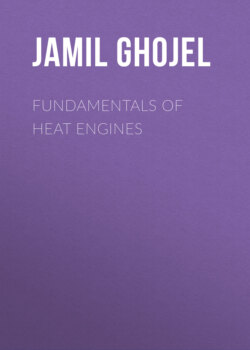Читать книгу Fundamentals of Heat Engines - Jamil Ghojel - Страница 49
1.3.4 Cycles
ОглавлениеWhen a fluid undergoes a series of processes and then returns to its initial state, the fluid executes a thermodynamic cycle. A cycle that consists only of reversible processes is a reversible cycle.
To illustrate the application of some of the processes discussed earlier when calculating cycles, let us consider the theoretical thermodynamic cycle shown in Figure 1.8, which is known as the Diesel cycle in honour of the German inventor Rudolf Diesel.
Figure 1.8 Application of process equations in theoretical cycles: (a) Diesel cycle; (b) calculation scheme for compression and expansion work.
The cycle has two heat‐only processes and two polytropic processes:
Process 2 − 3: Constant‐pressure heat addition Qin = mcp(T3 − T2).
Process 4 − 1: Constant‐volume heat rejection Qout = mcv(T4 − T1).
Process 1 − 2: Adiabatic compression PVγ = C (C is the constant in Eq. 1.48).
The magnitude of the compression work done on the gas can be determined as shown in Figure 1.8b:
where
p: average pressure for the shaded area
dV: volume increment
Since p = C/Vγ,
Now
C = p1V1γ = p2V2γ,
and hence,
(1.54)
Since pV = mRT, the compression work can be rewritten as
(1.55)
Process 3 − 4: Adiabatic expansion PVγ = C. The magnitude of the expansion work done by the gas can be deduced in a similar way:
(1.56)
or
(1.57)
If the sign convention given in Figure 1.9 is used, the compression work is negative work and the expansion work is positive work.
Figure 1.9 Sign convention for heat and work.
